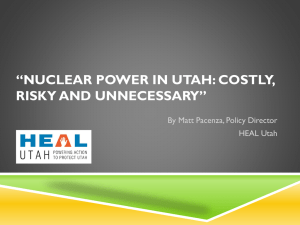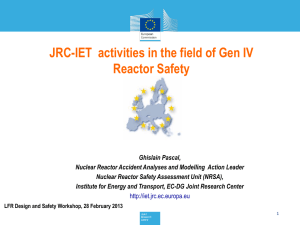The Next 30 Years of Nuclear Power : The Generation III / IV Dilemma
advertisement
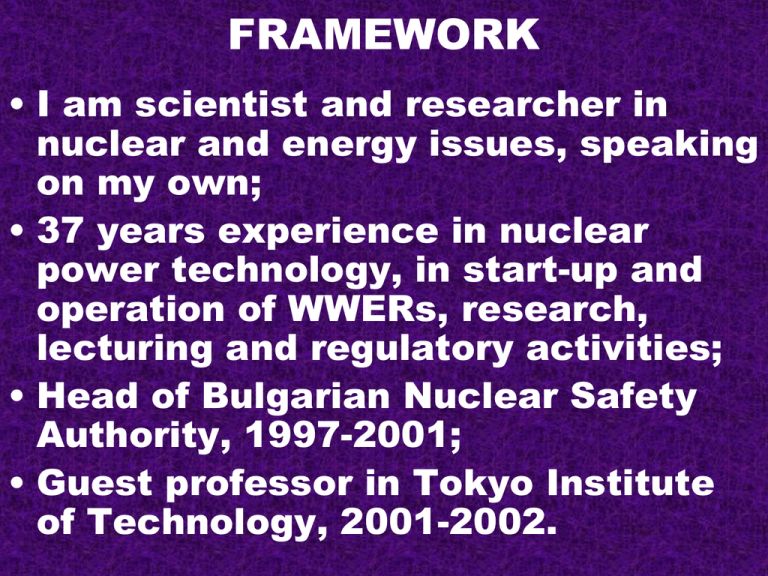
FRAMEWORK • I am scientist and researcher in nuclear and energy issues, speaking on my own; • 37 years experience in nuclear power technology, in start-up and operation of WWERs, research, lecturing and regulatory activities; • Head of Bulgarian Nuclear Safety Authority, 1997-2001; • Guest professor in Tokyo Institute of Technology, 2001-2002. Today's Nuclear Fleet • 435 nuclear power reactors (368 GW) in operation in 30 states, only a few of Generation 3. The total number and capacity worldwide at plateau during recent decade; • 63 reactors under construction, majority are of Generation 2; • The average age of operating reactors – 26 years; • 138 reactors shutdown, average age – 23 years • Nuclear share in electrical generation about 12 %, decrease from historical maximum of 17 %; • 2006 – peak in generated electricity, during following years – 4 % decrease; • 134 power reactors in European community, down from maximum 177 in 1989; • Asian countries (China, Korea, India, Pakistan) and Russia are the center of nuclear industry; Main Risks in NPPs • Use of fission chain reaction, which could be uncontrollable under curtain set of conditions; • High density of heat generation in the reactor core; • Huge amount of radioactive isotopes in the reactor core (activity about E+20 Bq at power level), contaminated equipment and buildings; • Components under high pressure, high temperature and dynamic loads; • Residual radiation/heat generation; • Generation of spent fuel and radioactive waste; • Additional; • Complacency, negligence, self-confidence, lack of ability to learn from others, underestimation of threats, lack of questioning attitude. Nuclear safety of NPP in absolute sense does not exists! Accidents will occur! INES SCALE • INES has seven Levels, with Level 7 being the most severe. There is also a Level 0, which is considered to be below the scale and having no safety significance; • Events classified as INES Level 1 through 3 are referred to as "incidents". Events classified as INES Level 4 through 7 are referred to as "accidents". INES SCALE ACCIDENTS BEFORE INTRODUCTION - One accident Level 7 (release equivalent to more than several tens (50) of thousands of TBq of 131I) – 1986, Chernobyl Unit 4, USSR; - One accident Level 6 (release equivalent to a release of thousands to tens (5-50) of thousands of TBq of 131I – 1957, Kyshtym, USSR; - Two accidents Level 5 (release equivalent to hundreds to thousands of TBq of 131I) – 1957, Windscale, UK and 1979, Three Mile Island Unit 2, US; - One known accident classified as Level 4 (the Saint Laurent des Eaux accident, 1990, France) INES SCALE EVENTS AFTER INTRODUCTION One Level 4 - Tokaimura criticality accident, 1999, Japan. At least 123 Level 3 incidents worldwide since 1991. Main reasons include wrong design, complacency, negligence, self-confidence, poor safety culture, lack of ability to learn from others, underestimation of threats, etc. - Data falsification in TEPCO reactors, Japan, 1992-2004; - Reactor pressure vessel head corrosion at Davis-Besse NPP, USA, 1990-2002. About 15x12,5x17,5 cm hole in the main material; - Ex-core fuel damage in Paks NPP unit 2, Hungary, 2003. 30 fuel assemblies severely damaged, big radioactive releases to the environment, unit shutdown for 17 months; - Anticipated Transient Without Scram (ATWS) waiting to happen at Kozloduy NPP unit 5, Bulgaria, 2005-2006. Neutron absorbers jammed in upper position, 22 of 61 inoperable even with control rod drive mechanisms; - Loss of off-site power and failure of 2 from 4 emergency trains at Forsmark NPP unit 1, Sweden, 2006; - During recent years concerns expressed regarding the quality of designs, equipment and services in nuclear industry. Residual Risks Report FUKUSHIMA IMPACT 0N EUROPE • • • • • • • Germany - permanent closure of 8 reactors and planned abandonment of nuclear power in the country till 2011; Switzerland - termination of discussions to construct new NPP and imposition of dates for final shutdown of the fife reactors; Italy - abandonment, by public referendum, construction of proposed new NPP; Belgium – in October 2011 conformed that in accordance with the 2003 nuclear phase - out law the three reactors will be shutdown in 2015 and the rest four – in 2025; Reconsideration and delay in nuclear programs in the number of countries; Implementation of “Stress tests” of European NPPs. Reduction by 50 % of the previous estimate of IAE for the new nuclear generating capacity worldwide for 2035; STRESS TESTS OF EUROPEAN NPPS • • • • The stress tests of European NPPs as defined by European Council should be “a comprehensive and transparent risk assessment ” of the plants; European Nuclear Safety Regulators Group (ENSREG) defined “stress test” as a targeted reassessment to the extreme natural events; Stress tests will be accomplished on voluntary basis. There are countries outside EU with nuclear power reactors. STRESS TESTS OF EUROPEAN NPPS The main and super ordinate target of “stress tests” would be (only) mitigation of big radioactive releases to the environment following a severe incident. Three questions have to be answered: • • • How to avoid re-criticality of the nuclear material even the control systems are not available; What additional devices and procedures are needed to cool the core and spent fuel pool for long time. How long it takes for fuel rods to start melting?; What additional devices and procedures are needed to keep radioactive materials inside the containment or to mitigate emissions to the environment. STRESS TESTS OF EUROPEAN NPPS • • • • The report should consists of four main parts: Up-to-date plant description; Description of the design basis of the plant and weather the plant copes with its design requirements; Assessment of so-called “robustness” beyond the design basis in case of earthquake and flooding and total loss of electrical power; Description of potential improvements. STRESS TESTS OF EUROPEAN NPPS LIMITED SCOPE • • • • • • • • • Only power reactors included; Only external hazards are considered, Internal hazards (break of components, pipe leakage, fires, cooling circuit clogging, electrical surges, etc.) combination of events, human errors, safety culture, defense in depth, other aspects are not considered; No consideration on the quality of equipment and systems and on the degradation/aging effects; Prevention of accidents almost not discussed; Crash of heavy airplane not discussed; Terrorists activities not discussed; Civil liability for nuclear damage not discussed; Stress tests are not a periodical safety review of STRESS TESTS OF EUROPEAN NPPS LIMITED TIME • • • • Limited time to accomplish the stress tests by nuclear operators (less than 6 months) - no new studies and investigations; The existing studies do not take into account multiunit plant design, do not consider circumstances of Fukushima accident, some are “customer friendly”, some of them (PSA) were completely wrong; The time for regulators to prepare evaluation too short (less than three month); Limited time for peer review (January 2012 – STRESS TESTS OF EUROPEAN NPPS NO CRITERIA • • • • No common calculation methods and criteria how to evaluate the seismic hazard; Robustness – what is this? No criteria for acceptance level; Stress tests mostly relay on “engineering judgment”; No requirements about the format of reports, not possible to compare reports of different countries. STRESS TESTS OF EUROPEAN NPPS LACK OF INDEPENDENCE • • • • • • No independent safety regulator in European Union; The stress tests accomplished by the same organizations (operators, regulators, technical support organizations) and the same experts that have been responsible for the plant safety in the past (remember test falsification by TEPCO); The main players are in visible conflict of interest; The experience show a number of accidents where nuclear operators and regulators demonstrated lack of competence and responsibility; The experience show the safety requirements differ from country to country; The key nuclear organizations failed to acknowledge the real severity of Fukushima accident. STRESS TESTS OF EUROPEAN NPPS LACK OF TRANSPARANCY AND OPENNESS • • • • • No independent experts and NGOs are involved in the preparation of reports; Reports and the main underlying documents are not open to the public; No public discussion in the countries; Limited participation of independent experts in the review process; Limited participation of the public in the discussions at European level. STRESS TESTS OF NPPS WHAT WOULD BE A RESULT OF STRESS TEST TO FUKUSHIMA DAIICHI NPP BEFORE MARCH 11? STRESS TESTS CANNOT MAKE THE PLANTS SAFE STRESS TESTS OF EUROPEAN NPPS • • • • • • • POLITICAL DECISIONS ARE NEEDED BASED ON SIMPLE TECHNICAL CRITERIA: To shutdown reactors with significant seismic or other external hazards; To shutdown the oldest reactors of Generation 1; To shutdown reactors without full pressure containment covering the spent fuel pool; To stop construction of reactors on sites with significant external hazards; To construct only Generation 3 reactors; Comprehensive safety assessment according to the newest safety standards to all nuclear facilities with involvement of independent experts and public; Increase and unification of civil liability for nuclear damage. THANK YOU FOR YOUR ATTENTION


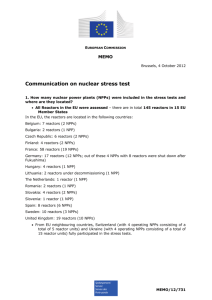
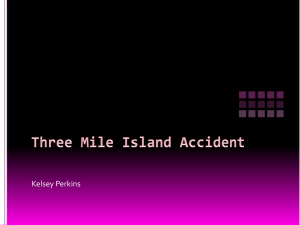



![The Politics of Protest [week 3]](http://s2.studylib.net/store/data/005229111_1-9491ac8e8d24cc184a2c9020ba192c97-300x300.png)
